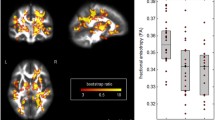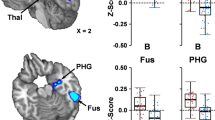Abstract
Memory problems are one of the most common symptoms of sport-related mild traumatic brain injury (MTBI), known as concussion. Surprisingly, little research has examined spatial memory in concussed athletes given its importance in athletic environments. Here, we combine functional magnetic resonance imaging (fMRI) with a virtual reality (VR) paradigm designed to investigate the possibility of residual functional deficits in recently concussed but asymptomatic individuals. Specifically, we report performance of spatial memory navigation tasks in a VR environment and fMRI data in 15 athletes suffering from MTBI and 15 neurologically normal, athletically active age matched controls. No differences in performance were observed between these two groups of subjects in terms of success rate (94 and 92%) and time to complete the spatial memory navigation tasks (mean = 19.5 and 19.7 s). Whole brain analysis revealed that similar brain activation patterns were observed during both encoding and retrieval among the groups. However, concussed athletes showed larger cortical networks with additional increases in activity outside of the shared region of interest (ROI) during encoding. Quantitative analysis of blood oxygen level dependent (BOLD) signal revealed that concussed individuals had a significantly larger cluster size during encoding at parietal cortex, right dorsolateral prefrontal cortex, and right hippocampus. In addition, there was a significantly larger BOLD signal percent change at the right hippocampus. Neither cluster size nor BOLD signal percent change at shared ROIs was different between groups during retrieval. These major findings are discussed with respect to current hypotheses regarding the neural mechanism responsible for alteration of brain functions in a clinical setting.








Similar content being viewed by others
References
Audoin B, Ibarrola D, Ranjeva JP, Confort-Gouny S, Malikova I, Ali-Cherif A, Pelletier J, Cozzone P (2003) Compensatory cortical activation observed by fMRI during a cognitive task at the earliest stage of MS. Hum Brain Mapp 20:51–58
Bluml S, Brooks W (2006) Magnetic resonance spectroscopy of traumatic brain injury and concussion. In: Slobounov S, Sebastianelli W (eds) Foundations of sport-related brain injuries. Spinger, NY, pp 197–220
Brett M, Anton J-L, Valabregue R, Poline J-B (2002) Region of interest analysis using an SPM toolbox [abstract]. Presented at the 8th International Conference on Functional Mapping of the Human Brain, 2–6 June, Sendai, Japan. Available on CD-ROM in Neuroimage 16(2)
Bryant R, Harvey A (1999) Postconcussive symptoms and posttraumatic stress disorder after mind traumatic brain injury. J Nerv Ment Dis 187:302–305
Burgess N, Maguire A, O’Keefe J (2002) The human hippocampus and spatial and episodic memory. Neuron 35:625–641
Cantu R (2006) Concussion classification: ongoing controversy. In: Slobounov S, Sebastianelli W (eds) Foundations of sport-related brain injuries. Springer, NY, pp 87–111
Cao C, Slobounov S (2009) Alteration of cortical functional connectivity as a result of traumatic brain injury revealed by graph theory, ICA and sLORETA analyses of EEG signals. IEEE (in press)
Chen JK, Johnston KM, Frey S, Petrides M, Worsley K, Ptito A (2004) Functional abnormalities in symptomatic concussed athletes: an fMRI study. Neuroimage 22:68–82
Chen J-K, Johnston K, Collie A, McCrory P, Ptito A (2007) A validation of the post concussion symptom scale in the assessment of complex concussion using cognitive testing and functional MRI. J Neurosurg Psychiatry 78:1231–1238
Chiaravalloti N, Hillary F, Ricker J, Christodoulou C, Kalnin A, Liu WC et al (2005) Cerebral activation patterns during working memory performance in multiple sclerosis using fMRI. J Clin Exp Neuropsychol 27(1):33–54
Curtis C, D’Esposito M (2003) Persistent activity in the prefrontal cortex during working memory. Trends Cogn Sci 7:415–423
Daselaar S, Prince S, Dennis N, Hayes S, Kim H, Cabeza R (2009) Posterior midline and ventral parietal activity is associated with retrieval success and encoding failure. Front Hum Neurosci 3:1–10
Dennis N, Cabeza R (2007) Neuroimaging of healthy cognitive aging. In: Craik F, Salthouse T (eds) The handbook of aging and cognition, 3rd edn. Psychology Press, New York
Friston KJ, Holmes AP, Worsley KJ, POline J-P, Frithh CD, Frackowiak RSJ (1995) Statistical parametric maps in functional neuroimaging. A general linear approach. Hum Brain Mapp 2:189–210
Garnett MR, Blamire AM, Corkill RG et al (2000) Early proton magnetic resonance spectroscopy in normal-appearing brain correlates with outcome in patients following traumatic brain injury. Brain 123:2040–2054
Garnett MR, Corkill RG, Blamire AM et al (2001) Altered cellular metabolism following traumatic brain injury: a magnetic resonance spectroscopy study. J Neurotrauma 18:231–240
Guskiewicz K (2003) Assessment of postural stability following sport-related concussion. Curr Sport Med Rep 2(1):24–30
Guskiewicz K, Mihalik J (2006) The biomechanics and pathomechanics of sport-related concussion: looking at history to build the future. In: Slobounov S, Sebastianelli W (eds) Foundations of sport-related brain injuries. Springer, NY, pp 65–84
Hartley T, Maguire E, Spiers H, Burgess N (2003) The well-worn route and the path less traveled: distinct neural bases of route following and wayfinding in humans. Neuron 37:877–888
Hayes S, Ryan L, Schnyer D, Nadel L (2004) An fMRI study of episodic memory: retrieval of object, spatial and temporal information. Behav Neurosci 118:885–896
Hillary FG (2008) Neuroimaging of working memory dysfunction and the dilemma with brain reorganization hypotheses. J Int Neuropsychol Soc 14(4):526–534
Hillary FG, Chiaravalloti ND, Ricker JH, Steffener J, Bly BM, Lange G et al (2003) An investigation of working memory rehearsal in multiple sclerosis using fMRI. J Clin Exp Neuropsychol 25(7):965–978
Hillary FG, Genova HM, Chiaravalloti ND, DeLuca J (2006) Prefrontal modulation of working memory performance in brain injury and disease. Hum Brain Mapp 27:837–847
Iaria G, Chen J, Guariglia C, Ptito A, Petrides M (2007) Retrosplenial and hippocampal brain regions in human navigation: complementary functional contributions to the formation and use of cognitive maps. Eur J Neurosci 25:890–899
Jancke L, Cheetham M, Baumgartner T (2009) Virtual reality on the role or prefrontal cortex in adults and children. Front Neurosci 3(1):52–59
Jantzen KL, Anderson B, Steinberg FL et al (2004) A prospective functional MR imaging study of mild traumatic brain injury in collegiate football players. Am J Neuroradiol 25:738–745
Janzen G, Weststeijn C (2007) Neural representation of object location and route direction: an evernt-related fMRI study. Brain Res 1165:116–125
Kessels R, Pastma A, Wijnalda E, Haan E (2000a) Frontal-lobe involvement in spatial memory: evidence from PET, fMRI, and lesion studies. Neuropsych Rev 10:101–113
Kessels RPC, de Haan EHF, Kapelle LJ, Postma A (2000b) Varieties of human spatial; memory: a meta-analysis of the effects of hippocampal lesions. Brain Res Rev 10:295–303
Kirov I, Fleysher L, Babb JS, Silver JM, Grossman RI, Gonen O (2007) Characterizing ‘mild’ in traumatic brain injury with proton MR spectroscopy in the thalamus: initial findings. Brain Inj 21(11):1147–1154
Lovell M, Collins M, Iverson G, Field M, Maroon J, Cantu R, Rodell K, Powell J, Fu F (2003) Recovery from concussion in high school athletes. J Neurosurg 98:296–301
Lovell MR, Pardini JE, Welling J, Collins MW, Bakal J, Lazar N, Roush R, Eddy WF, Becker JT (2007) Functional brain abnormalities are related to clinical recovery and time to return-to-play in athletes. Neurosurgery 61(2):359–360
Maldjian JA, Laurienti PJ, Burdette JB, Kraft RA (2003) An automated method for neuroanatomic and cytoarchitectonic atlas-based interrogation of fMRI data sets. Neuroimage 19:1233–1239
McAllister TW, Saykin AJ, Flashman LA et al (1999) Brain activation during working memory I month after mild traumatic brain injury: a functional MRI study. Neurology 53:1300–1308
McAllister TW, Sparling MB, Flashman LA, Guerin SJ, Mamourian AC, Saykin AJ (2001) Differential working memory load effects after mild traumatic brain injury. Neuroimage 14(5):1004–1012
McAllister TW, Flashman LA, McDonald BC, Saykin AJ (2006) Mechanisms of working memory dysfunction after mild and moderate TBI: evidence from functional MRI and neurogenetics. J Neurotrauma 23:1450–1467
McCrory P, Meeuwisse W, Johnston K, Dvorak J, Aubry M, Molloy M, Cantu R (2009) Consensus statement on concussion sport: the 3rd international conference on concussion in sport. Br J Sport Med 43:176–184
McNamara T, Shelton A (2003) Cognitive maps and the hippocampus. Trends Cogn Neurosci 7(8):333–335
Niogi SN, Mukherjee P, Ghajar J, Johnson CE, Kolster R, Lee H, Sun M, Zimmerman R, Manley G, McCandliss B (2008) Structural dissociation of attentional control and memory in adults with and without mild traumatic brain injury. Brain 131:320–3221
Oldfield RC (1971) The assessment and analysis of handedness: the Edinburgh inventory. Neuropsychologia 9:97–113
Pantano P, Mainero C, Caramia F (2006) Functional brain reorganization in multiple sclerosis: evidence from fMRI studies. J Neuroimage 16:104–114
Parslow D, Rose D, Brooks B, Fleminger S et al (2004) Allocentric spatial memory activation of the hippocampal formation measured with fMRI. Neuropsychology 18:450–461
Perlstein WM, Cole MA, Demery JA, Seignourel PJ, Dixit NK, Larson MJ et al (2004) Parametric manipulation of working memory load in traumatic brain injury: behavioral and neural correlates. J Int Neuropsychol Soc 10(5):724–741
Ptito A, Chen J-K, Johnston K (2007) Contribution of functional magnetic resonance imaging (fMRI) to sport concussion evaluation. Neurorehabilitation 22:217–227
Reddy CC, Collins MW (2009) Sports concussion: management and predictors of outcome. Curr Sports Med Rep 8(1):10–15
Rosenbaum R, Furey M, Horwitz B, Grady C (2008) Altered connectivity among emotion-related brain regions during short-term memory in Alzheimer’s disease. Neurobiol Aging 10:724–741
Sanchez-Carrion R, Fernandez-Esprjo D, Junque C, Falcon C, Burgallo N, Roig T, Bernabeu M, Torsmos J, Vendrell P (2008) A longitudinal fMRI study of working memory in severe TBI patients with diffuse axonal injury. Neuroimage 43:421–429
Schrader H, Mickrevičiene D, Gleizniene R, Jakstiene S, Surkiene D, Stovner L, Obelieniene D (2009) Magnetic resonance imaging after most common form of concussion. BMC Med Imag 9(11) (this article is available from: http://www.biomedcentral.com/1471-2342/9/11)
Shaw N (2002) The neurophysiology of concussion. Prog Neurobiol 67:281–344
Slobounov S, Sebastianelli W, Cao C, Slobounov E, Newell K (2007) Differential rate of recovery in athletes after first versus and second concussion episodes. Neurosurgery 61(2):238–244
Slobounov S, Cao C, Sebastianelli W, Slobounov E, Newell K (2008) Residual deficits from concussion as revealed by virtual time-to-contact measures of postural stability. Clin Neurophysiol 119(2):281–289
Slobounov S, Cao C, Sebastianelli W (2009) Differential effect of single versus recurrent mild traumatic brain injuries on wavelet entropy measures of EEG. Clin Neurophysiol 120(5):862–867
Tollard E, Galanaud D, Perlbarg V, Sanchez-Pena P, Le Fur Y, Abdennour L, Cozzone P, Lehericy S, Chiras J, Puybasset L (2009) Experience of diffusion tensor imaging and 1H spectroscopy for outcome prediction in severe traumatic brain injury: preliminary results. Crit Care Med 37(4):1448–1455
Trouillas P, Tkayanagi T, Hallett M, Currier D, Subramony S, Wessel K, Bryer A, Diener H, Massaquoi S, Gomez C et al (1997) International cooperative ataxia rating scale for pharmacological assessment of the cerebellar syndrome. J Neurol Sci 145:205–211
Voermans N, Petersson K, Daudey L, Weber B, van Spaendonck K, Kremer H, Fernández (2004) Interaction between the human hippocampus and the caudae nucleus during route recognition. Neuron 43:427–435
Ward N (2005) Plasticity and the functional reorganization of the human brain. Int J Psychophysiol 58:158–161
Wirth W, Hartmann T, Boecking S, Vorderer P, Klimmt C, Schramm H et al (2007) A process model of the formation of spatial presence experience. Med Psychol 9:493–525
Witmer BG, Singer MJ (1998) Measuring presence in virtual environments: a presence questionnaire. Presence Teleop Virtual Environ 7:225–240
Zhou Y, Dougherty J, Hubner K, Bai B, Cannon RK, Hutson R (2008) Abnormal connectivity in the posterior cingulate and hippocampus in early Alzheimer’s disease and mild cognitive impairment. Alzheimers Dement 4(4):265–270
Acknowledgments
This study was supported by NIH Grant RO1 NS056227-01A2 “Identification of Athletes at Risk for Traumatic Brain Injury” awarded to Dr. Slobounov, PI. We would like to thank Elena Slobounov for VR programming and Dr. Susan Lemieux for fMRI design development. All human studies have been approved by the The Pennsylvania State University IRB and all subjects gave their informed consent prior to their inclusion in the study.
Author information
Authors and Affiliations
Corresponding author
Rights and permissions
About this article
Cite this article
Slobounov, S.M., Zhang, K., Pennell, D. et al. Functional abnormalities in normally appearing athletes following mild traumatic brain injury: a functional MRI study. Exp Brain Res 202, 341–354 (2010). https://doi.org/10.1007/s00221-009-2141-6
Received:
Accepted:
Published:
Issue Date:
DOI: https://doi.org/10.1007/s00221-009-2141-6




